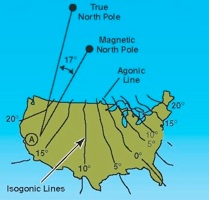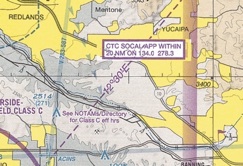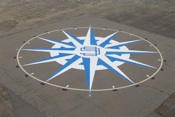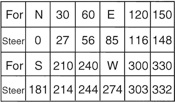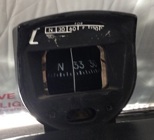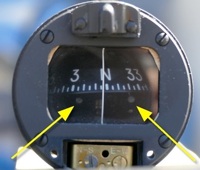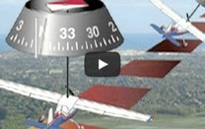If you're getting ready for a Private, Instrument or Commercial check ride, you may want to bone up on the very exciting magnetic compass and all its errors. In this GPS / ForeFlight world, pilots seldom look at the compass, but you still need to know how it works, and, when it doesn't work so well. You’ll find a compass on virtually every airplane from the smallest two seat trainer to jumbo jet airliners. It’s the one instrument that needs no electrical, static or vacuum system to function. But there are some unique attributes related to its simplicity that you must be aware of.
TWO NORTH POLES
First, all our charts are referenced to the
true north pole (where
True North and Magnetic North poles.
Santa Claus lives); yet the location of the
magnetic north pole is really 1,300 miles away. This presents the first issue: to navigate using a chart designed off of
true --- or geographic --- north, while using a compass that instead wants to point to
magnetic north. This requires us to correct for the difference between the two. This angular difference between true and magnetic north is known as
variation. It changes geographically - near Chicago it's almost non existent - the true north pole is nearly perfectly aligned
right behind magnetic north; but in Southern California, the magnetic north pole is twelve to thirteen degrees east of true north, so we adjust a course plotted on a sectional chart by subtracting thirteen degrees from true north, so that our magnetic course in the airplane more directly corresponds to what the compass is going to indicate. East is least (subtract); West is best (add West variation). The
Isogonic line in Southern California.
broken red line on your sectional chart is the
isogonic line depicting the amount of variation in your area. You can help remember the difference between variation and deviation, which we’ll discuss next, as variation varies --- based on where the airplane is flying (but irrespective of its actual heading).
The next error common to all magnetic compasses is
deviation. Deviation is the result of the electrical and avionics system and other metal in our airplane. It can change based on the heading of the airplane, so the AMT will determine the amount of error on each of the cardinal headings by taxiing the airplane to a compass
Compass rose painted on airport surface.
rose painted on the airport surface and noting the amount of error when the nose is pointed on each of those headings. Just as you might deviate from a heading, so too is deviation tied to the heading of the airplane (unlike variation, it is irrespective of where in the world the airplane happens to be flying.) This correction error --- or deviation --- is then written on the
Example of a Compass Correction Card.
compass card which is affixed to the front face of the compass itself. A compass correction card is a required placard and marking in an airplane. If part, or all, of your compass correction card is missing, your airplane is not airworthy for
This airplane is not airworthy, as the Compass Correction Card is missing.
flight, and the insurance company will not cover you if you take off in this condition. (FAR 23.1547)
The last two errors I'll cover are related to the construction of the compass itself. These are known as
dip errors. This cutaway diagram of a compass shows the card floating in a kerosene-like fluid, which helps to dampen its movement.
The card has a steel pivot in its center that rides inside a hard glass jewel cup. This all works well in straight and level, unaccelerated flight; in fact, that is the only flight condition when the compass is truly usable. But when turning or accelerating or decelerating, the magnets on the card try to align with the lines of magnetic flux between the north and south pole. This causes a downward deflection or --- dip --- of the compass card. In a bank, the compass card dips to the low side of the turn, giving an incorrect turn indication.
This error is most apparent on North and South headings. When turning from a heading of North the compass briefly gives an indication of a turn in the opposite direction. When turning from a heading of South, the direction of turn indicated is correct, but the rate of turn of the compass is faster than the actual turn rate. When turning from the North, the compass lags; when turning from the South, the compass leads. You can remember these nuances by using the acronym
UNOS --- Undershoot North, Overshoot South. When turning to a heading of north, roll out on a compass heading of about 30-degrees
before your desired course, anticipating that lag (330º or 030º, depending if you’re turning left or right). When turning to South, roll out
after the compass turns to a heading of about 30 degrees more than your desired on course heading, to account for the lead of the compass. (150º or 210º, again,
After you read the article... watch the video. Click image to watch YouTube video.
depending whether you’re turning left or right). This 30º over/under works pretty well in Southern California; in other parts of the country or on the other side of the equator, you'll have to figure this out for yourself.
ACCELERATE/DECELERATE
The final compass anomaly I'll touch on are acceleration and deceleration errors, which are nothing more than the effect of inertia on that compass card which is pivoting on top of a jewel cup. If the airplane accelerates on a heading of East, the inertia of the weight holds the float back and the card rotates toward North.
Undershoot
North
Overshoot
South
Accelerate
North
Decelerate
South
As soon as the speed of the airplane stabilizes, the card swings to its East indication. If flying East and decelerating, the inertia causes the weight to move ahead and rotates toward South until the speed again stabilizes. The same thing happens when heading West. This anomaly is similar to what happens to a loose object in your car. When you step on the gas, the object (or your head) dips back, just like the compass would. When you slam on the brakes (decelerate) the box of kleenex on your rear window shelf dips forward. A great memory trigger for these errors is
ANDS --- Accelerate North ---- Decelerate South. When you accelerate the airplane, the compass indicates a turn toward North. When you decelerate, it indicates a turn toward South.
Remember, when you're headed North, the ends of the magnets that are aligned with North are actually on the
back side of the compass (toward the nose of the airplane). You're
looking at the South side of the compass card --- that's why, unlike your Heading Indicator, compass headings get
lower to the right of North. When you turn to the right, the compass card seems to swing to the left, not the right, like a Heading Indicator would. (In reality, much like a gyro,
The other end of the North-seeking magnets. These are long, thin tubes that cause the dip and acceleration errors discussed in this article.
the compass card is staying aligned with North, and the
airplane is turning around the fixed compass. Be sure you understand this concept.) This confuses most student pilots and more than a few Instrument Rating students. You have to resolve how the compass actually works to get this straight in your mind. In the picture to the right, you can see the ‘South’ end of the magnets on either side of the 'N' cardinal heading (indicated by yellow arrows).
For more on the Mag Compass, review Section 7 of the FAA’s Pilot’s Handbook of Aeronautical Knowledge. Then observe how these errors occur in your airplane the next time you fly.
© Garry Wing 2016

